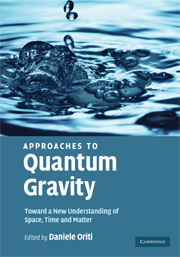Book contents
- Frontmatter
- Contents
- List of contributors
- Preface
- Part I Fundamental ideas and general formalisms
- Part II String/M-theory
- Part III Loop quantum gravity and spin foam models
- 13 Loop quantum gravity
- 14 Covariant loop quantum gravity?
- 15 The spin foam representation of loop quantum gravity
- 16 Three-dimensional spin foam Quantum Gravity
- 17 The group field theory approach to Quantum Gravity
- Questions and answers
- Part IV Discrete Quantum Gravity
- Part V Effective models and Quantum Gravity phenomenology
- Index
14 - Covariant loop quantum gravity?
from Part III - Loop quantum gravity and spin foam models
Published online by Cambridge University Press: 26 October 2009
- Frontmatter
- Contents
- List of contributors
- Preface
- Part I Fundamental ideas and general formalisms
- Part II String/M-theory
- Part III Loop quantum gravity and spin foam models
- 13 Loop quantum gravity
- 14 Covariant loop quantum gravity?
- 15 The spin foam representation of loop quantum gravity
- 16 Three-dimensional spin foam Quantum Gravity
- 17 The group field theory approach to Quantum Gravity
- Questions and answers
- Part IV Discrete Quantum Gravity
- Part V Effective models and Quantum Gravity phenomenology
- Index
Summary
Introduction
In recent years, loop quantum gravity (LQG) has become a promising approach to Quantum Gravity (see e.g. for reviews). It has produced concrete results such as a rigorous derivation of the kinematical Hilbert space with discrete spectra for areas and volumes, the resulting finite isolated horizon entropy counting and regularization of black hole singularities, a well-defined framework for a (loop) quantum cosmology, and so on. Nevertheless, the model still has to face several key issues: a well-defined dynamics with a semi-classical regime described by Newton's gravity law and General Relativity, the existence of a physical semi-classical state corresponding to an approximately flat space-time, a proof that the no-gravity limit of LQG coupled to matter is standard quantum field theory, the Immirzi ambiguity, etc. Here, we address a fundamental issue at the root of LQG, which is necessarily related to these questions: why the SU(2) gauge group of loop quantum gravity? Indeed, the compactness of the SU(2) gauge group is directly responsible for the discrete spectra of areas and volumes, and therefore is at the origin of most of the successes of LQG: what happens if we drop this assumption?
Let us start by reviewing the general structure of LQG and how the SU(2) gauge group arises. In a first order formalism, General Relativity (GR) is formulated in term of tetrad e which indicates the local Lorentz frame and a Lorentz connection ω which describes the parallel transport.
- Type
- Chapter
- Information
- Approaches to Quantum GravityToward a New Understanding of Space, Time and Matter, pp. 253 - 271Publisher: Cambridge University PressPrint publication year: 2009
- 1
- Cited by

